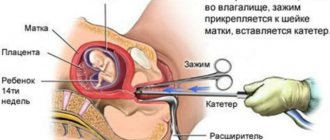Artificial termination of pregnancy is a difficult test for women's health. Stress and hormonal imbalances lead to delayed periods after an abortion. Bloody discharge that appears immediately after the procedure has nothing to do with menstruation. The egg simply does not have time to mature during this time. She needs at least 20 days.
It may take 3-6 months for the cycle to completely normalize. The duration of recovery depends on how long and how the interruption occurs. The doctor’s experience and compliance with rehabilitation recommendations play an important role. The age and health status of the patient is also important.
Types of abortions
Pregnancy can be terminated at the request of the woman only up to the twelfth week. At a later date, this procedure is possible only for medical or social reasons: if the patient is diagnosed with diseases that are dangerous to her life or if a severe pathology is diagnosed in the fetus. A woman who has not yet given birth should be especially careful when choosing the method of this manipulation. Having assessed all the indications and risks, the doctor recommends the best possible method of terminating the pregnancy.
There are the following methods of performing an abortion:
- mini-abortion - a way to remove the embryo from the uterus using a vacuum;
- surgical - removal of the fertilized egg by curettage;
- pharmabort - the use of medications.
In case of late abortion, the drug is administered directly through a puncture of the amniotic sac, after which the fetus is removed from the uterine cavity.
Signs of pathology
We told you how many days after an abortion menstruation usually occurs if the patient is in good health. But this operation does not always end successfully. If your period begins a little earlier or your period does not come after an abortion, it is better to go to the clinic.
So, you should be wary of critical days, which may begin earlier. But don't confuse them with bleeding, which everyone has. A woman’s period a week after an abortion, which began immediately after the operation, is the consequences of this procedure; in fact, these are not critical days. When removing the fetus, the doctor injures the vessels, so blood will flow from them until they are completely healed. But if heavy periods suddenly begin after an abortion, and even with clots, ahead of schedule, this may be a sign of uterine bleeding. It usually appears after intimacy or heavy exertion. In this case, you should immediately see a doctor.
Much depends on exactly what kind of menstruation after an abortion. If the following symptoms appear, you should immediately go to the clinic:
- The discharge has an unpleasant odor or has an unusual consistency: it is too liquid or clots have appeared in it.
- Clots in menstruation are yellow and contain bloody impurities.
- Menstruation is accompanied by unpleasant sensations that were not there before.
All these are signs of infection. If they make themselves felt, it is necessary to undergo a course of treatment, otherwise chronic diseases and then infertility may appear.
Characteristics of types of abortions
The classic method (curettage) is carried out until the twelfth week of pregnancy. It is performed using medical surgical instruments in a clinical setting. The fertilized egg is separated mechanically from the wall of the reproductive organ. Before the procedure begins, the cervix is artificially dilated, through the canal of which instruments for manipulation will be inserted and the fertilized egg will be removed. The procedure is painful, so it is performed with the use of analgesic drugs. For some time after the manipulation, the woman is under the supervision of a medical professional.
In a vacuum abortion, a device is inserted into the uterine cavity, which creates negative pressure in it. This helps to tear the fertilized egg away from its attachment site. This procedure is performed until the fifth week from the moment of conception (no later than 20 days from the delay). After it, you definitely need to undergo an examination by your attending physician, since it is not always possible to aspirate all the contents and the possibility that the pregnancy has persisted cannot be ruled out. This manipulation is carried out only in a clinical setting.
Medication interruption is performed in the early stages (before the fifth week). The effectiveness of this procedure is ninety-five cases out of a hundred: the shorter the period, the more successful the procedure. With this method, a drug is used that increases the tone of the muscles of the mother’s reproductive organ - it has an effect opposite to the effect of progesterone.
After taking the drug, the process of expulsion of the fetus becomes irreversible; the woman can no longer change her mind about terminating the pregnancy.
Bleeding may begin within a few hours of using the product, more often after one or two days. The embryo leaves the uterine cavity with menstrual flow. At this time, the patient must be re-examined by the attending physician to ensure the positive result of the abortion. A woman can stay at home all the time.
Why you need to know about female physiology
The monthly cycle of a woman of reproductive age is the joint “work” of the endocrine glands. Two of them - the hypothalamus and pituitary gland - are located in the cranial cavity and issue “commands” in the form of hormones. The third gland, the ovaries, receives and processes them. It is these three internal secretion organs that decide how long a woman’s cycle will last.
But the nature and volume of menstrual flow, although regulated by hormones, also depends on the thickness and degree of blood supply to the functional layer of the endometrium of the uterus. It is these epithelial cells that prepare to receive the embryo, and if it does not form, they are rejected during menstruation. The thickness and restoration of the functional endometrium is regulated by the underlying layer - the basal layer, which is sensitive to female gonadotropins. The basal layer is capable of recovering after damage by surgical instruments, but it cannot do this as quickly as the functional layer.
Causes of scanty periods during surgical abortion
After termination of pregnancy, menstruation does not stop for some time. They look like normal menstruation. This is due to the fact that the inner layer of cells, which grows monthly and is separated if pregnancy does not occur, has sloughed off and leaves the uterus naturally. The vessels are damaged as a result of the abortion and continue to bleed.
Scanty periods after curettage may be the result of excessively thorough cleaning of the inner layer of the uterus during the process of mechanical removal of the embryo.
In addition, a powerful restructuring occurs in the pregnant woman’s body, facilitating the bearing of a child. After an abortion, a woman's body experiences hormonal imbalance. One of the manifestations of such dissonance is spotting.
If the medical worker is poorly qualified, mechanical damage to the uterus may occur. In this case, blood can flow into the abdominal cavity or permeate the walls of the reproductive organ itself.
The cervix, mechanically dilated, can close, and the blood will not be able to get out, accumulating in the cavity. The danger of such a complication is that blood is an excellent breeding ground for various microorganisms, and against this background the development of purulent inflammation is possible.
Pathological causes
Hormonal imbalances lead to the fact that menstruation does not go away. During the period of taking contraceptives, spotting secretion instead of heavy bleeding may appear for 4, 6 or more months. The list of non-gynecological symptoms leading to scanty pinkish leucorrhoea includes:
- anemia (lack of hemoglobin in the blood);
- vitamin deficiency, in which there is an insufficient supply of oxygen to the body;
- hormonal imbalances;
- cardiovascular diseases;
- slow metabolism;
- psychological disorders;
- gastrointestinal pathologies.
The list of gynecological reasons includes:
- Ectopic pregnancy. It is difficult for a woman to determine that she has conceived, since pregnancy tests give negative results. She will feel severe abdominal discomfort and symptoms of body intoxication. The absence of heavy menstruation is the only sign by which a dangerous condition can be suspected. Additional symptoms of the pathology: nagging pain in the lower back, discomfort when going to the toilet, flatulence, enlarged mammary glands, severe manifestations of toxicosis. The most dangerous complication of an ectopic pregnancy is internal bleeding due to a ruptured fallopian tube. The problem more often than other gynecological pathologies causes infertility in girls.
- Risk of miscarriage. According to statistics, about 10% of pregnancies end in miscarriages. The main symptom of the onset of a miscarriage is if brown mucus smears for 4 days. The main reason for termination of pregnancy is a lack of the hormone progesterone in the female body.
- Inflammatory processes of the uterus and ovaries. If there is a problem, the blood vessels penetrating the genitals bleed under any mechanical influence.
- Sexual infections that occur in a latent form: gonorrhea, chlamydia, trichomoniasis. If there is a problem, the spotting whites will have dark shades and an unpleasant odor. In the secreted secretion, a woman will be able to see inclusions of pus. With an exacerbation of STIs, the clinical picture is supplemented by pain when urinating, burning in the lower abdomen, and itching in the vagina.
- Endometriosis. The disease is diagnosed annually in 10% of women of reproductive age. One of the manifestations of the disorder is brownish leucorrhoea instead of menstruation for the second month. The patient may feel discomfort during sexual intercourse.
- Cervical erosion. Represents manifestations on the mucous membranes. Deep erosions lead to minor bleeding after sex or during the use of vaginal suppositories. Thickening of the endometrium of the uterus. The disease is accompanied by scanty spotting instead of menstruation and, if not treated in a timely manner, can be complicated by oncology.
- Adenomyosis is a pathology that occurs after numerous abortions and curettages. Instead of menstruation, dark red discharge appears on the pad. Adenomyosis is accompanied by cutting pain above the pubis and a general deterioration in well-being.
Causes of scanty discharge after pharmaabortion
Termination of pregnancy with Mirolute is carried out in the early stages, when the endometrium has not yet had time to grow significantly and the embryo has not yet firmly attached to the uterine wall. Scanty bleeding after mirolut may be normal. However, it happens that the reason for such periods after medical termination of pregnancy is hidden in the following:
- significant hormonal changes, in which the menstrual cycle is restored only after a few months;
- mechanical obstruction to the outflow of blood through the vagina (tightly closed cervix, blood clot above the vaginal opening).
The latter reason poses a serious threat to a woman’s life and the ability to bear a child in the future. Surgery may be necessary to correct this complication. In addition, there is a possibility that the pregnancy has continued.
Heavy menstruation: protects Totem
The drug Totem from Innotec International (France) contains 5 mg of iron gluconate, 133 μg of manganese gluconate and 70 μg of copper gluconate in 1 ml. This iron-containing drug is available in the form of drinking ampoules and is prescribed 1-3 ampoules per day for a period of 1-3 months for iron deficiency anemia, including after heavy periods after a miscarriage. The dose and duration of taking Totema is determined individually depending on the severity of iron deficiency and the results of laboratory blood tests. The drug Totema is well tolerated. It has undergone numerous studies and has proven itself in practice as a highly effective drug for correcting iron deficiency. A special feature of the drug Totema is also that the copper and manganese contained in the drug Totema contribute to a faster and more effective elimination of iron deficiency anemia.
Related articles:
Heavy periods after miscarriage
Heavy periods after a miscarriage are not uncommon. In some cases, they may be a normal option for 1-2 menstrual cycles. But sometimes heavy periods after a miscarriage are a sign of complications and require treatment.
Heavy periods: reasons
Heavy periods in women can indicate a variety of pathologies and require consultation with a specialist. Heavy periods are a serious problem, which is scientifically called “mennorrhagia.” Heavy periods can cause anemia.
Heavy periods after childbirth
Heavy periods are a very common problem faced by women. Heavy periods often occur after childbirth.
What is heavy periods (menorrhagia)?
Heavy periods (menorrhagia) are established as a diagnosis for prolonged or heavy menstruation. Heavy periods are characterized as menorrhagia with a duration of more than 7 days, and blood loss is 80 ml or more.
Menstruation after medical termination of pregnancy should not differ significantly from normal menstruation in terms of onset and nature. Their onset indicates the restoration of ovarian function and the equalization of hormonal levels. But after taking the pills, there is a possibility of a delay.
Symptoms of scanty periods after an abortion
Scanty menstruation after an abortion is manifested by the fact that the volume of blood released is significantly reduced, and only traces of it remain on the pad. During the entire period of menstruation, no more than 50 ml of blood can be released.
Spotting lasts from one to two days, but can last for a month, releasing several drops per day. The blood may be scarlet and fresh, but more often it is brown.
If the wall of the uterus is mechanically damaged during surgery, the patient experiences acute pain in the abdomen, which intensifies when it is touched. The stomach becomes bloated and constipation occurs. Body temperature rises and thirst appears. The patient's general condition worsens over time. In severe cases, a woman’s consciousness becomes confused. If you do not consult a doctor in a timely manner, the patient may die.
Minor bleeding may be accompanied by disturbances in a woman’s general well-being: her mood deteriorates, irritability appears, bloating or nagging pain in the lower abdomen occurs. Painful sensations of aching nature in the mammary glands cannot be ruled out.
Menstruation is normal
The physiological menstrual cycle lasts 21-35 days - this is how much time the body needs to prepare the uterus for conception.
Over 3-7 days of menstruation, a total of 50-70 ml of blood should be released, and together with mucus and cells of the functional layer - up to 120 ml. In this case, the blood may be red or dark brown; Large blood clots (more than a 50-kopeck coin) should not be released. The smell of the discharge should not be nasty or putrid. No green or yellow liquid should appear along with blood or ichor.
Diagnostic methods
After a thorough questioning and examination, the attending physician prescribes the following examinations:
- examination of the patient on the chair;
- determination of the content of sex hormones in blood and urine;
- examination of vaginal contents under a microscope;
- sowing the discharge onto a nutrient medium to identify pathological microorganisms in the vagina;
- Ultrasound of the female genital organs to determine possible damage to the uterus;
- To determine the moment of ovulation, monitor your basal temperature.
Temperature is measured in the rectum. Use a mercury thermometer. The measurement is taken every morning before getting out of bed. The woman records the indicators on a chart. An upward jump in temperature indicates the onset of ovulation.
Deviations from the norm
If after the procedure the blood comes out with yellow impurities, this indicates the presence of an infection in the body. This pathology appears due to a sudden change in the microflora in the vagina. At the time of abortion, this condition is considered extremely dangerous; sepsis often develops against its background and the likelihood of infertility increases significantly. If the situation becomes critical and the egg does not leave the uterus by this time, an emergency abortion is performed using the vacuum method or through surgery.
If after the procedure there is no discharge at all, this usually indicates cervical spasm. Her muscles contract and do not allow the embryo to leave the cavity. In other words, the abortion remains unsuccessful. This condition provokes the development of inflammation and improper formation of the fetus.
Restoring the menstrual cycle after medical abortion
How quickly the menstrual cycle will be restored after such a hormonal shock as pharmaabortion depends on several important factors.
When do you get your period after medical termination of pregnancy? Factors influencing the restoration of menstruation after medical abortion:
- Timing of termination of pregnancy. The earlier the drug abortion was done, the greater the chance of the body recovering quickly and without complications.
- Woman's age. The most optimal age for medical abortion is 20-35 years.
Patients under 20 years of age and after 35 years of age can be prescribed pharmaboration only on the individual recommendation of a doctor. - Health status. A woman’s strong immune system and completely healthy body will tolerate such a procedure more easily than a patient with chronic diseases and weak immunity.
- Having bad habits. This is especially true for smoking. If a woman has been addicted to nicotine for many years, she should definitely notify her doctor about this. After pharmaabortion, nicotine accumulated in the body can cause severe bleeding.
- Rehabilitation period. If you follow all the doctor’s recommendations regarding nutrition, daily routine, physical activity and rest, the patient will contribute to the speedy recovery of her body. This means that the monthly cycle will be restored in the shortest possible time.
- Having a natural birth, before abortion. A patient who has already had experience of natural childbirth before an abortion will recover from this procedure much faster than a woman who has not given birth.
- Quality of medicines. The correctly selected dosage and quality of the abortifacient drugs themselves significantly influence the outcome of this event.
- Level of qualification of medical personnel. An experienced, qualified specialist will select the right drug and the correct dosage, and will also give all recommendations regarding the recovery period.
Scanty periods after medical termination of pregnancy
Menstruation after a medical abortion should not immediately be scanty and strange in appearance - this is a pathology, and also the fact that they do not begin. It can signal complications such as:
- Undilated cervix.
Medicines taken during pharmacist abortion provoke a “miscarriage”. If at this time the cervix has not been able to fully open, then the accumulation of blood and fragments of the fertilized egg begins in it.And this is fraught with inflammatory processes and more serious complications. If the “daub” is accompanied by fever and pain in the lower abdomen, you should immediately go to the doctor.
- Remaining pregnancy.
If a delay in menstruation or very scanty discharge is accompanied by toxicosis, cramping pain in the lower abdomen, then these symptoms indicate an incomplete termination of pregnancy, perhaps the pregnancy continues to develop and it was not possible to terminate it. In this case, the doctor prescribes an ultrasound. If pregnancy is confirmed, surgical abortion may be prescribed.
Bleeding after abortion
After medical termination of pregnancy, how many days does the period last?
During the first two days after taking the abortifacient medication, the woman should have a heavy discharge.
This is due to the fact that the fertilized egg separates from the mucous surface of the uterus, the blood vessels rupture, hence profuse bleeding appears.
How long does your period last after medical termination of pregnancy? Normally they last from 5 to 10 days. The fertilized egg is separated in parts, which is why the discharge continues for such a long period. By its nature, the discharge should be a little more than during menstruation.
How are your periods after medical termination of pregnancy?
The discharge turns into bleeding if, in a short period of time in less than thirty minutes, a pad designed for heavy periods marked super, maxi or 5-7 drops is completely filled.
The following factors can provoke bleeding:
- Remaining fragments of the fertilized egg in the uterus.
If the embryo does not come out completely or part of the fertilized egg, for some reason, does not separate from the uterine mucosa, this can cause bleeding. In this case, you should immediately consult a doctor. - Physical exercise.
Lifting weights and physical exercise on the abs in the first two weeks after pharmaboration should be completely avoided. - High ambient temperature.
A hot bath, sauna, steam bath, and even being outside in direct sunlight at air temperatures above +25 degrees have an adverse effect on a woman after a pharmabortion. - Injury received in the abdominal area.
Any injury received in the abdominal area is dangerous for a woman during the rehabilitation period.Therefore, you should maintain bed rest, walk carefully and protect yourself from falling.
- Using tampons.
After a medical abortion, the use of tampons is strictly prohibited; until the uterus is completely healed, only pads should be used.
Heavy periods - the path to anemia
Heavy periods in women often provoke the development of anemia. The total blood loss during menstruation is about 80 milliliters, which is equivalent to 5.5 tablespoons of blood. That is, normally, blood loss is minimal, but heavy periods are already a significant “leakage” of iron from the body, a path to the development of iron deficiency anemia. At the same time, the level of hemoglobin in the blood decreases, and if the hemoglobin is low, it means that the woman is suffering from anemia. It is always necessary to identify the cause of anemia and be sure to eliminate it. People suffering from anemia have reduced immunity - they suffer from infectious diseases for a long time and often.
First period after medical abortion
When will my period start after medical termination of pregnancy? The first menstruation after medical termination of pregnancy will come with a slight deviation in time. In most cases, disruptions in the menstrual cycle are minor.
How to determine the date of the first monthly cycle?
When does menstruation begin after medical termination of pregnancy? The day on which heavy discharge began after taking an abortifacient medication is considered the first day of a new menstrual cycle.
Subsequent monthly cycles occur and should proceed according to the woman’s individual schedule. If before the abortion the cycle was 28 days, then your period should begin between 28 and 38 days.
How long after medication interruption does menstruation begin and when should I expect it? It all depends on how disrupted the woman’s hormonal levels are. A delay of 10 - 13 days of menstruation after a medical abortion (after 2 weeks) is considered normal and should not cause cause for concern.
A gap of 40 or 60 days of delayed menstruation after an abortion indicates deviations; in this situation, you need to consult a gynecologist and determine the cause of this delay.
After medical termination of pregnancy, the monthly cycle is restored within six months.
During this period, slight deviations from the individual cycle may be observed, and delays occur more often.
Blood loss increases, periods become heavier, and pain may be present.
The restoration of a clear menstrual cycle indicates the complete rehabilitation of women's health.
This is the first indicator that the body has endured hormonal stress and is recovering. During this period, it is very important not to expose yourself to new challenges in the form of an unwanted pregnancy. A repeated abortion performed in a very short period of time can lead to infertility or very serious complications. Even if a couple really wants to conceive a baby, it is better to wait with this issue for the first six months after the pharmaabortion.
Pregnancy is not always a joyful event for a woman. When the life situation does not allow to bear and give birth to a child at a certain period, the expectant mother decides to have an abortion.
In the early stages of unwanted gestation, the gynecologist may recommend pharmabort to the patient - a medical method of terminating pregnancy. It is considered safe for women's health and the reproductive system in particular.
But after undergoing pharmaabortion, a woman should know when her periods begin and then carefully protect herself until she is completely ready for motherhood.
The essence of pharmabort
Tablet abortion is carried out in a clinic under the supervision of a gynecologist. For this purpose, tablets containing mefipristone or misoprostol are used. They affect the uterus and provoke an abortifacient effect.
Medical abortion is provided by drugs such as:
- Mifepristone.
- Mytholian.
- Mifegin.
- Misoprostol.
- Pencrofton.
- Peaceful.
The abortifacient works effectively in small stages of pregnancy, which do not exceed 6 weeks. The drug reduces the level of progesterone, as a result of which the fertilized egg is rejected and leaves the uterine cavity along with bloody discharge.
To perform a tablet abortion, the doctor simultaneously uses two drugs - Mifepristone and Misoprostol. Medicines stimulate the contractile function of the reproductive organ. The increased contraction of the muscle fibers of the uterus forces the fertilized egg to leave its location.
Pharmabort has many advantages:
- High quality of manipulation – 92 – 99%.
- No need for preliminary preparation or anesthesia.
- The procedure is quick – the whole process comes down to taking pills.
- Atraumatic for the endometrium and cervix.
- Preservation of reproductive functions.
- Normal tolerability of the procedure in psychological terms.
However, pharmabort also has disadvantages.
First of all, doctors say that sometimes the embryo is not rejected. If the drug does not work properly, the fertilized egg remains completely or partially in the uterus. It can only be removed through traditional abortion.
Other disadvantages of medical abortion:
- Uterine bleeding (55% of cases).
- Nausea.
- Severe abdominal pain.
- Temperature increase.
- Dizziness.
- Weakness.
- Increased blood pressure.
- Hormonal disorders.
- Infectious diseases of the genital organs.
The body can react to a medical abortion with allergic reactions. Eliminate the side effect with antihistamines.
Video:
How do your periods go after pharmaabortion?
After completing the pharmaboration, a new countdown of the menstrual cycle begins. When do you get your first period after a medical abortion?
In most cases, bleeding appears within 1 to 2 days. Initially it is meager, but gradually intensifies. The unwanted egg leaves the body during heavy bleeding. Next month there may be a delay in menstruation.
In general, menstruation after medical termination of pregnancy has its own characteristics, which at other times may be perceived as a deviation.
For example, after a pharmaceutical abortion, a delay of up to 10 days is considered normal. The cycle is restored slowly over 6 months. The duration of the cycle after drug intervention in gestation increases. But this is not a deviation. Intense bleeding, as well as too little discharge for a long time, already requires a visit to a doctor.
Normally, the next menstruation after using abortifacient medications should begin 28 to 40 days later. After the procedure, the gynecologist monitors its quality by performing an ultrasound. If during the examination the device did not show the remains of the fertilized egg, it means that the rejection of the embryo was successful and there will be no complications.
When asked how long menstruation lasts after a medical termination of pregnancy, doctors give the following answer: blood will be released from the uterus within 1 week. Sometimes it takes longer for the body to completely reject the embryo. For example, 10 or 11 days. A miscarriage appears as a bloody mass with clots.
Heavy bleeding after a pill abortion is associated with hormonal disorders or the development of endometriosis.
The doctor will be able to determine why periods are heavy after a thorough examination of the patient. But often pharmabortion does not lead to significant cycle disruptions. Period delays of up to 10 days should not be a cause for concern. A woman cannot know exactly when her period will begin after a medical termination of pregnancy. She just needs to wait for bleeding and monitor the stability of its occurrence in another cycle.
The speed of cycle recovery is influenced by several factors:
- Age.
- General health.
- Doctor's qualifications.
- Quality of abortifacient drugs.
- The period at which gestation was interrupted.
In young women with a short period of pregnancy, restoration of the reproductive system after pharmaabortion takes place in 1 to 2 months.
Video:
Possible complications
Whether there will be a delay after medical termination of pregnancy, whether menstruation will be painful or not, how long the bleeding will continue - all these questions are covered by the doctor.
The specialist will also tell you about complications that may arise after an abortion. One of the complications may be severe bleeding. If the patient loses more than 150 ml of blood over all days, she is prescribed hemostatic drugs. Bleeding cannot be ignored, as it causes weakness, anemia and pressure changes.
Serious complications of pharmaabortion include incomplete cleansing of the uterus. Remains of the embryo and amniotic membranes accumulate inside the organ due to incorrect dosage of the drug. If you skip this moment and do not start treatment, the main reproductive organ will suffer from severe inflammation. As a result, infertility will develop. Incomplete abortion without medical assistance is fatal.
Vomiting, cramping abdominal pain and high body temperature indicate poor quality of pharmacological abortion. If the pills did not affect the integrity of the embryo, you will still have to get rid of it by curettage of the uterine cavity. It is impossible to leave the child, since abortive manipulations in the future will affect its development, and the baby will be born defective or dead.
In the first six months after a medical abortion, it is important to strengthen contraceptive measures. Frequent episodes of abortion at a young age are dangerous for oncological changes in the genital organs.
Contraindications
Medical termination of pregnancy is carried out at the request of the woman or in the case when there is a medical ban on childbirth in the near future, and fertilization of the egg has occurred. In such a situation, it is better to terminate a short-term pregnancy using a medical abortion, rather than a conventional abortion with curettage.
An ectopic pregnancy cannot be removed with pills; it can only be removed during surgery.
Before medical termination of pregnancy, it is necessary to do an ultrasound to determine the location of the fertilized egg. If it is fixed in the ovary, fallopian tube or peritoneum, the doctor will prohibit you from doing a pharmabortion.
Other contraindications to medical abortion:
- Allergy to components of the abortifacient drug.
- Long-term use of glucocorticosteroids.
- Kidney and liver failure.
- Inflammatory diseases of the reproductive system.
- Severe gynecological pathologies.
- Myoma and malignant changes of the uterus.
- Period of treatment with anticoagulants.
- Disturbances in the blood coagulation system.
If a woman smokes and is over 35 years of age, the doctor may refuse to perform a pill abortion.
PS Remember that a medical abortion puts the body into shock. Many organs and systems undergo changes, and the woman herself reacts to this event with increased fatigue and psychological disorders.
If the patient’s health condition cannot be considered excellent, after pharmaabortion she may have infectious and inflammatory diseases of the internal genitalia or long-term delays in menstruation.
Every second woman puts her body at risk when deciding to terminate an unwanted pregnancy. Modern medicine offers a gentle method of getting rid of the fertilized egg using hormonal drugs. However, it does not guarantee a 100% result and requires strict medical supervision of the procedure. Representatives of the fair sex are especially concerned about the question of when menstruation comes after medical termination of pregnancy.
Pharmacological abortion: what is it?
Medical abortion is a forced termination of pregnancy using pharmaceutical means. Its use is indicated on the 42-49th day of delayed menstruation, which is equal to 6-7 weeks. The likelihood of successful completion of the procedure directly depends on the time of absence of menstruation: the shorter the delay, the higher the guarantee of termination of pregnancy. However, in some countries, pharmacological abortion is allowed up to 24 weeks.
Medical termination of pregnancy is carried out using medications whose main active ingredient is the hormone mifepristone, for example, Mifegin, Pencrafton, Mifeprex, Mifolian. The effect of hormonal drugs is to block progesterone, which leads to the rejection of the fetal egg and its release from the uterus, accompanied by bleeding. In turn, misoprostol replaces prostaglandin, which stimulates contraction of the uterine organ, which helps remove the remains of the fertilized egg from the uterus. Medicines are taken under the strict supervision of a doctor and according to a schedule, taking into account the individual capabilities of the woman.
After an abortion induced by medication, it is mandatory to undergo an ultrasound of the pelvic organs to check for the presence of remnants of the fertilized egg. If the uterine organ is clean, then the risk of complications is minimal. According to medical indications, for preventive purposes after a pharmacological abortion, additional therapy with antibacterial agents and for hormone levels is prescribed.
Pros and cons of medical abortion
Any medical procedure has different consequences. For example, after a drug abortion, bleeding begins or, conversely, your period may not come. Therefore, it is necessary to know all the advantages and disadvantages of this procedure.
The main advantages of medical abortion include:
- High effectiveness of the technique. In 92-99% of cases the procedure is successful.
- Minimum or no preparatory activities.
- Painless and quick: the manipulation is reduced to the usual oral administration of tablets.
- No anesthesia or narcotic sleep is required.
- Exclusion of surgical curettage, which preserves the integrity of the cervix and endometrium of the uterus.
- No psychological trauma.
- Does not affect the reproductive functions and fertility of a woman.
However, there are also some disadvantages of pharmacological abortion that you should pay attention to before taking the medicine:
- Insufficient effect of the drug leads to the abandonment of the fertilized egg or part of it, the removal of which requires surgical intervention.
- High risk of uterine bleeding, fraught with heavy blood loss. In rare cases, surgery or blood transfusion is required.
- Severe pain in the lower peritoneum, which appears on the second day after taking the pills and is often accompanied by a feeling of discomfort and nausea.
- Body hyperemia and high temperature.
- Headaches and dizziness.
- Sudden jumps in blood pressure.
- Allergic reactions or individual intolerance to the drug.
- The hormonal nature of the pills leads to changes in the balance of hormones and threatens with unpredictable results.
- Infectious lesions of the female genital organs.
- Accumulation of blood clots in the uterine cavity, or hematometra, provoked by spasm of the uterine cervix.
- Difficulty in determining the arrival of menstruation.
In addition, it is not recommended to take medications that cause fetal rejection if the pregnancy is over 6 weeks. If the timing is inaccurate, the traditional method of abortion is used.
Likely consequences
Medical abortion is considered preferable for women of any age compared to classical surgery. Typically, the drugs used during this procedure are effective and well tolerated by the body. True, in some cases women face various problems after such an abortion. Thus, many people complain of dizziness, skin rashes, and nausea in the first hours after taking medications. But in the second stage of abortion there is a high risk of abnormal bleeding.
Even before the procedure, the doctor must warn the patient about the possible consequences. The most common among them include the following conditions:
- hematometra - appears due to spasm of the cervix, characterized by the accumulation of clots in the cavity;
- placental polyp - a particle of the embryo remains inside, causing abnormal bleeding;
- deviations in hormonal levels;
- depressed, depressed state, suicidal attacks.
Restoration of the menstrual cycle
All patients, without exception, are concerned about the question of when menstruation will begin after a medical abortion and how many days will it take for it to become established. After pharmacological termination of pregnancy, the menstrual cycle forms again. Its first day (1-2 days after taking the medicine) coincides with the onset of bleeding, signaling the detachment of the fertilized egg and the release of the egg. When menstruation begins, there is scanty bleeding, which should be replaced by heavy bleeding, which is a sign of the release of the female gamete. Then the vaginal secretions become spotty. Bleeding after a medical abortion usually lasts 7–10 days and indicates a gradual detachment of the endometrium. The intensity of blood secretion directly depends on physical activity. In this regard, after pharmacological termination of pregnancy, bed rest is recommended in the first two days.
It is impossible to determine exactly how long your period lasts after a medical abortion. The timing depends on the individual characteristics of the female body and is determined by lifestyle, physique, general health and age.
When menstruation arrives, a woman must strictly monitor the discharge. If they are scanty, this is not a very good sign, indicating closure of the cervix, making it difficult to expel the fertilized egg. Severe bleeding that does not stop for more than 2 days indicates a complication. In such cases, mandatory medical consultation is indicated.
Normal periods after medical termination of pregnancy begin according to the patient’s previously established menstrual cycle. The average time for the onset of real menstruation is on average 28 – 35 days. As a rule, it is painless.
According to medical statistics, 60% of patients regain their previous menstrual cycle. However, the onset of critical days has some features:
- A delay in menstruation after a medical abortion can be 10 days. This is considered normal.
- After this manipulation, it increases in most women. This physiological process is not a delay.
- Complete restoration of the menstrual cycle occurs within six months.
Delayed monthly bleeding may occur until the cycle stabilizes. If the delay in menstruation after medical termination of pregnancy continues for more than two expected periods of critical days, you must make an appointment with a gynecologist. Based on the results of a manual examination and ultrasound examination, if necessary, the doctor will prescribe medications to help restore the cycle.
Women's comments
During my second pregnancy, I noticed that on the third day I was smearing pink mucus. I went to see a gynecologist. The doctor discovered that I had a frozen pregnancy and advised me to go to the hospital. At the hospital I had a curettage performed. After this, normal periods began after 2 months, and after 6 months the gynecologist allowed me to start planning a child again.
Evgenia. 22
I found out that I was getting pregnant by my periods, which anointed and went away. The doctor said that this is normal in the first months after conceiving a child. The pregnancy went well. She gave birth on her own, without complications.
I went to the gynecologist because my stomach constantly hurts and bloody spots appear on my underwear. After examination, the doctor diagnosed uterine polyposis. On the fourth day after my treatment, I had surgery to remove the overgrown tumors. After the intervention, I went to the gynecologist every month and took medications to prevent the problem from reoccurring.
Termination of an unwanted pregnancy can be performed using different methods depending on the duration of pregnancy, the condition of the fetus and the health of the mother, and the qualifications of the specialist. Scanty periods after an abortion may be normal or indicate the development of a complication.
What to do if menstruation does not occur
The use of medications during a pharmacological abortion does not guarantee one hundred percent termination of pregnancy. Many patient reviews prove that in 2% of cases the fertilized egg is not rejected. It persists if there is no period for a long time after termination of pregnancy with the help of medications, and the patient exhibits all its symptoms: toxicosis, dizziness, weakness.
If the interesting situation is confirmed by the doctor, then in this case he recommends terminating the existing pregnancy. In such a situation, the risk of abnormal fetal development increases. The decision in any case remains with the woman.
Medical termination of pregnancy is a consequence of hormonal imbalance, which can cause various female diseases. If the patient complains of deterioration in health, accompanied by an increase in temperature, cramping pain in the lower abdomen, then these symptoms may indicate complications of medical abortion, or more precisely, incomplete rejection of the fertilized egg from the uterine cavity. As a rule, such situations occur with late (over 8 weeks) pharmacological termination of pregnancy.
This pathology can only be diagnosed using ultrasound. Doctors recommend doing it twice: in the first 3 days after an abortion and on days 7–10.
The absence of menstruation for a whole month or more (over 40 days) is also a reason to consult a specialist.
A change in hormonal levels caused by taking medications increases the risk of getting pregnant again after an abortion (actually 1-2 weeks) before the onset of menstruation and is also accompanied by a delay. If symptoms accompany pregnancy, mandatory and repeated pregnancy tests and blood tests for hCG are indicated. Positive results are a signal to visit the gynecologist who performed the procedure.
Often, after a pharmacological abortion, doctors prescribe hormonal contraceptives to women to prevent pregnancy and normalize the menstrual cycle. A new conception within six months after an abortion is undesirable.
Regular visits to the gynecological office will help to avoid possible complications and reduce the likelihood of pathologies of the reproductive organs.
Contraindications to pharmacological abortion
Medical termination of pregnancy is considered a gentle method, despite this there are a number of contraindications that exclude the use of this method of termination of pregnancy. These include:
- Abortion in the late stages of more than 8 weeks is dangerous due to incomplete rejection of the fertilized egg.
- Age restrictions: before the age of 18, medical termination of pregnancy is undesirable, since hormonal imbalance can harm a young, not fully formed body.
- Women over 35 who smoke are at risk of developing cardiovascular pathologies.
- Ectopic pregnancy. Medicines that cause rejection of the fertilized egg can cause the fallopian tubes to contract and cause them to rupture, the consequences of which (excessive internal bleeding) can be fatal.
- Hormonal imbalance caused by taking birth control pills or having an intrauterine device. You must inform your doctor about these factors.
- Infections and inflammations of the female genital organs (fibroma, fibroids, endometriosis, malignant tumors, uterine scar).
- Presence of chronic diseases:
- circulatory system (anemia, hemophilia);
- adrenal insufficiency accompanied by epilepsy;
- liver and kidney pathologies;
- diseases of the gastrointestinal tract (colitis, gastritis, pancreatitis);
- respiratory problems;
- diseases of the heart and blood vessels;
- hypertension;
- obesity;
- diabetes;
- extragenital pathology of severe form.
- Individual intolerance to drugs.
Abortion using medications can only be prescribed by a gynecologist. It is carried out in a medical institution so that in case of complications the patient can receive timely assistance from highly qualified specialists.
Take care of your health! Use contraception so as not to expose your body to the risk of developing pathologies.
Publication date: Miscellaneous











